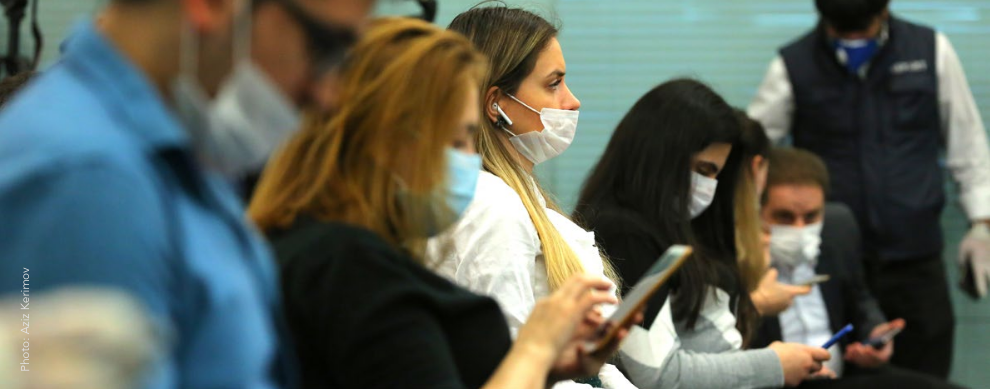Last update: 23 September 2020
Apart from the economic, political and societal consequences, the COVID-19 pandemic has exposed and aggravated all the inequalities that already existed and discriminates more against those who were already marginalised. This includes women. In previous epidemics, such as the ebola epidemic in West Africa, women suffered greater exposure to the virus and were more affected, which seems to be happening again.[1] A non-exhaustive list of examples is listed below.
- The large majority of the healthcare sector workers at the front line of the pandemic are women, meaning that they incur more health risks during this pandemic.[2]
- School closures are likely to have a greater impact on women, who in many societies take principal responsibility for children, but also for extended family members.[3]
- Domestic violence tends to rise during epidemics, as due to the lockdown, women spend more time with the potential perpetrator of that violence.
- Gender-based violence tends to rise during crises,[4] and connected to that, an increase in teenage pregnancies during school closures can be observed. This is very detrimental to girls’ chances of returning to schools once they are reopened and continuing their education.[5]
- Health crises can trigger economic crises, which tend to affect women disproportionately, particularly in low-income countries.[6] Income protection tends not to be targeted towards those working in the informal economy – who are often women making their livelihood working outside home.[7]
Women journalists reporting on COVID-19 from across the world, either from quarantine or on the front lines
Source: Women in Journalism
The gendered impacts of the COVID-19 pandemic are also visible in the media. According to a survey among journalists conducted by the International Federation of Journalists, more than half of the female respondents have experienced increased gender inequalities due to COVID-19, especially relating to their conciliation of work and private life, work responsibilities, and salaries.[8] On the one hand, the pandemic has shown gender inequality in the media sector.
- Free Press Unlimited’s Reporters Respond fund and Legal Defense Fund have seen a significant increase in requests from predominantly women journalists.
- A survey conducted by IFJ among women journalists showed that more than half of the respondents acknowledged an increase in gender inequalities in the industry, with devastating consequences on their conciliation of work and private life (62%), work responsibilities (46%) and salaries (27%).
- Many independent media outlets are struggling financially, and in newsrooms women are more likely to be fired than men during economic hardship.
On the other hand, the pandemic has shown gender inequality in media content.
- Even though, as shown above, the gendered impacts of this health crisis are clear, stories that focus on the perspectives of women and other minorities and vulnerable groups are scarce.
- Voices of women experts are vastly underrepresented: ‘the media and policymakers overwhelmingly turn to men as figures of scientific authority’.[9]
- Data is not sufficiently sex-disaggregated, which is needed in order to fully understand the way men and women are affected. In order to create effective policies, it is necessary to understand the pandemic’s differential impact on women and men, as ‘supporting gender analysis and sex-disaggregated data is an integral part of a strong COVID-19 response’.[10]
‘Media has the power to amplify the voices of women, portray their active roles in the Corona crisis, support their participation in public debate, challenge gender stereotypes and hold decision-makers accountable for women rights.’
– Emma Boberg Lygnerud, International Media Support[11]
Learn more
Check out the Gender and Media Resource Guide to learn more about how to promote gender inequality in and through the media.
See this blog post for an overview of publications on the gendered aspects of the pandemic and how media can cover it in a gender-sensitive way.
As part of the campaign ‘Together for reliable information‘, Free Press Unlimited is producing a series of podcasts to highlight initiatives from its partners all over the world to keep bringing reliable information to the public. In this podcast Larissa Buschmann, Programme Coordinator Gender and Media, talks about how the COVID-19 crisis has aggravated a lot of existing problems for women, and how media can play their part in making a social change.
Footnotes
[1] Helen Lewis, The Coronavirus Is a Disaster for Feminism (The Atlantic)[2] Free Press Unlimited, COVID-19, Gender and Media
[3] David Evans, How Will COVID-19 Affect Women and Girls in Low- and Middle-Income Countries? (Center for Global Development)
[4 International Federation of Red Cross and Red Crescent Societies, Unseen, Unheard: Gender-based Violence in Disasters
[5] Oriana Bandiera et al., The Economic Lives of Young Women in the Time of Ebola
[6] David Evans, How Will COVID-19 Affect Women and Girls in Low- and Middle-Income Countries? (Center for Global Development)
[7] Phumzile Mlambo-Ngcuka, COVID-19: Women Front and Centre
[8] International Federation of Journalists, COVID-19 Has Increased Gender Inequalities in the Media, IFJ Survey Finds
[9] Teresa Carr, In COVID-19 Coverage, Female Experts Are Missing (NiemanLab)
[10] UN Women, COVID-19: Emerging Gender Data and Why it Matters
[11] International Media Support, Remember Gender in Your COVID-19 Coverage

